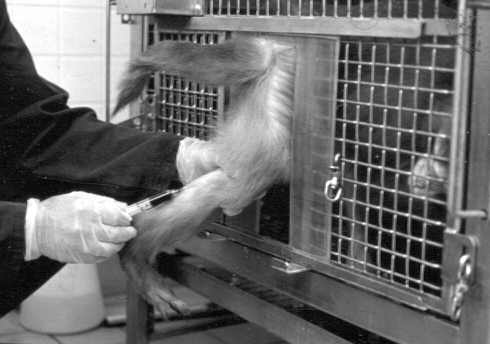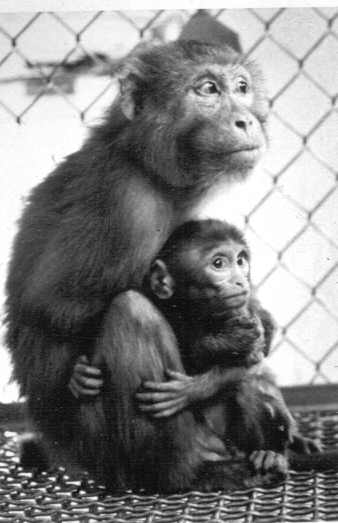By Viktor Reinhardt
There is a wide-spread belief that adult rhesus macaques are particularly aggressive animals (Vandenbergh, 1966; Southwick, 1967; Lindburg, 1971; Fairbanks et al., 1978; Teas et al., 1982; Thierry, 1985). They are supposedly not only belligerent toward humans and dangerous to handle, but also vicious toward other conspecifics and hence difficult to introduce to members of their own kind (Wickings and Nieschlag, 1980; Kessler et al., 1985; Line, 1987; Line et al., 1990; Reinhardt, 1991a). This notion is reflected in the conventional housing and handling of adult rhesus macaques assigned to research protocols -the animals are most often kept singly and handling procedures usually involve forceful restraint (Bayne, 1989). Both circumstances are unsatisfactory for the following reasons:
1. Continual single-housing of any social animal, including rhesus macaques, raises ethical and scientific concerns because it ignores the subject's species-typical need for social contact and interaction.
2. Enforced restraint of any animal, including rhesus macaques, is a distressing experience which should be avoided for obvious ethical reasons. It should also be avoided for scientific reasons, since distress is likely to affect the subject's physiology and emotional state.
Are there alternatives to single-caging and stressful handling for adult rhesus macaques which can guarantee the safety of both the animals and the personnel?
The rhesus' bad reputation is based on a belief with little verifiable evidence. It is true that adults, especially males, can inflict serious wounds with their razor-sharp dagger-like canines. It is also true that they can be extremely aggressive when introduced to strange conspecifics. This, however, does not prove that the animals are particularly aggressive by nature. After having studied the behavior of several animal species for many years, the author has come to the conviction that captive animals are not particularly aggressive; management-related circumstances, however, can make them aggressive. Such provoked aggression is defensive rather than offensive, and unskillful management and/or human behavior is responsible for it. Staring at a caged rhesus monkey, for example, is unskillful; the gesture acts as a threat, and the 'cornered' animal has little choice but to react in a defensively aggressive way. The author's experience with captive animals and commitment to their well-being inspired him from 1986 on to gradually develop the following alternative management practices for caged rhesus macaques, allowing for social housing and low-stress handling.

Handling
Venipuncture is the most common handling procedure research rhesus macaques are subjected to. The procedure involves manual or mechanical restraint which is usually feared and resisted by the animals. Using the animals' intelligence, the author developed a training technique - based on positive reinforcement, patience and gentle firmness - which ensures the subjects' cooperation during venipuncture in their home cages (Vertein and Reinhardt, 1989; Reinhardt, 1991b). Eighteen adult males and 17 adult females have been trained. Neither the trainer nor the animals received any injuries during the training.
Working with non-resisting experimental macaques in their familiar environment not only increases the scientific value of the research conducted by eliminating undue stress reactions (Reinhardt et al., 1990; Reinhardt et al., 1991), but also increases the safety of the personnel. Not being forcefully subdued, the animals are no longer unpredictable and ready to defend themselves by biting and scratching (Illustration 1).
Compatible juvenile companionship
In the course of ethological studies of breeding troops, the author has regularly witnessed adult rhesus macaques of both sexes being extremely tolerant toward infants, even during competition for food. It was also repeatedly observed that not only adult females but also adult males temporarily carried and cradled infants to whom they were not related (Illustration 2). These observations prompted the conclusion that adult rhesus macaques are usually inhibited from serious aggression towards infants, but rather show protective behavior toward them.
This inference proved to be correct. Previously singly-caged adults of both sexes were transferred to social pair-housing by introducing naturally weaned 12-18 months old infants from Wisconsin Regional Primate Research Center's breeding colony (Reinhardt et at., 1987). The young animals effectively inhibited overt aggression in the adult partners, who cared for them as if they were their own kin. Of more than 150 pairs tested, adults showed injuring aggression towards their companions in only two cases. Presently there are 110 adult-infant pairs at the Center (Reinhardt, 1991c); many of them were formed four years ago and have consistently remained compatible.
Compatible adult companionship
By nature, rhesus macaques live in relatively exclusive groups, showing intense aggressive reactions towards unfamiliar conspecifics (Southwick et at., 1974). Familiar group members relate to each other in accordance with dominance-subordination relationships which serve as basic social structures essential for harmonious group life (Kaufman, 1967; Vandenbergh,1967).
The author hypothesized that previously singly-caged adult rhesus macaques should get along with each other in pairs, if both partners were familiar with each other and had a dominance-subordination relationship established prior to pair formation. Accordingly, singly-caged adults of both sexes were paired with same-sexed partners after rank relationships had been established during a period of non-contact familiarization (Reinhardt, 1989). More than 350 pairs were tested in this way.
Aggressive disputes were negligible, probably because there was no need to physically reinforce already established rank relationships (Reinhardt, 1989). Rather than fighting over dominance, companions usually engaged in affiliative grooming and/or huddling soon after they were introduced to one another. Partners got involved in serious (but not life-threatening) aggression in only 3 pairs. Presently there are 108 adult female pairs and 29 adult male pairs at the WRPRC (Reinhardt, 1991c). Many of them were formed three years ago and have proven compatible throughout this time.
Thanks to their companions, the formerly singly-caged adults spend approximately 23% of their time actively expressing their social needs in species-typical ways (Reinhardt, 1990). Compatible companionship has made them truly social animals, and hence more valid research models.
Several years of experience with pair housing of previously singly-caged adult rhesus macaques and venipuncture in the home cage of cooperative, non-resisting animals lead the author to conclude that rhesus macaques are not as aggressive as commonly believed. The species' reputation for being conspicuously aggressive is evidently no reason for not transferring singly-caged individuals to a species-appropriate social environment, and to handle research subjects in gentle ways.

Acknowledgements
I am grateful to my wife Annie for providing constructive critical comments on my manuscript. Thanks are also due to Mrs. Jackie Kinney for proof-reading the text. This project was supported by NIH grant RR-00167 to the Wisconsin Regional Primate Research Center.
References
Bayne, K. (1989): Resolving issues of psychological well-being and management of laboratory nonhuman primates. In Housing, Care and Psychological Well-being of Captive and Laboratory Primates (ed. E.F .Segal), pp. 27-39. Noyes Publication, Park Ridge.
Fairbanks, L.A., McGuire, M.T., and Kerber, W. (1978): Effects of group size, composition, introduction technique and cage apparatus on aggression during group formation in rhesus monkeys. Psychological Reports 42, pp. 327 -333.
Kaufman, J.H. (1967): Social relations of adult males in a free-ranging band of rhesus monkeys. In Social Communication among Primates (ed. S.A. Altman), pp. 73-98. Chicago University Press, Chicago.
Kessler, M.F., London, W.T., Rawlings, R.G., Gonzales, F., Martines, H.S., and Sanchez, F. (1985): Management of a harem breeding colony of rhesus monkeys to reduce trauma-related morbidity and mortality. Journal of Medical Primatology 16, pp. 38-44.
Lindburg, D.G. (1971): The rhesus monkey in North India: an ecological and behavioral study. In Primate Behavior Vol. 2 (ed. L.A. Rosenblum), pp. 1-106. Academic Press, New York.
Line, S.W. (1987): Environmental enrichment for laboratory primates. Journal of the American Veterinary Medical Association 190, pp. 854-859.
Line, S.W., Morgan, K.N., Roberts, J.A., and Markowitz, H. (1980): Preliminary comments on resocialization of aged rhesus macaques. Laboratory Primate Newsletter 29, pp. 9-12.
Reinhardt, V., Houser, W.D., Eisele, S.G., and Champoux, M. (1987): Social enrichment with infants of the environment of singly caged adult rhesus monkeys. Zoo Biology 6, pp. 365-371.
Reinhardt, V. (1989): Behavioral responses of unrelated adult male rhesus monkeys familiarized and paired for the purpose of environmental enrichment. American Journal of Primatology 17, pp. 243-248.
Reinhardt, V. (1990): Time budget of caged rhesus monkeys exposed to a companion, a PVC pipe and a piece of wood for an extended time. American Journal of Primatology 20, pp. 51-56.
Reinhardt, V., Cowley, D., Scheffler, J., Vertein, R., and Wegner, F. (1990): Cortisol response of female rhesus monkeys to venipuncture in homecage versus venipuncture in restraint apparatus. Journal of Medical Primatology 19, pp. 601-606.
Reinhardt, V. (1991a): Group formation of previously single-caged adult rhesus macaques for the purpose of environmental enrichment. Journal of Experimental Animal Science 34, pp. 10-15.
Reinhardt, V. (1991b): Training adult male rhesus monkeys to actively cooperate during in-homecage venipuncture. Animal Technology 42, pp. 11-17.
Reinhardt, V. (1991c): Implementing an environmental enhancement plan for previously singly-caged Macaca mulatta at a research facility. Laboratory Primate Newsletter 30(3), pp. 4-5.
Reinhardt, V., Cowley, D., Eisele, S., and Scheffler, J. (1991): Avoiding undue cortisol responses to venipuncture in adult male rhesus macaques. Animal Technology 42, pp. 83-86.
Southwick, C.H. (1967): An experimental study of intragroup agonistic behavior in rhesus monkeys (Macaca mulatta). Behaviour 28, pp.182-209.
Southwick, C., Siddiqi, N., Farooqui, M., and Pal, B. (1974): Xenophobia among free-ranging rhesus group in India. In Primate Aggression, Territoriality, and Xenophobia, (ed. R. Holloway), pp. 185-209. Academic Press, New York.
Teas, J., Feldman, H.A., Richkie, T.L., Taylor, H.G., and Southwick, C.H. (1982): Aggressive behavior in the free-ranging rhesus monkeys of Kathmandu, Nepal. Aggressive Behavior 8, pp. 63- 77.
Thierry , B. (1985): Patterns of agonistic interactions in three species of macaque (Macaca mulatta, M. fascicularis, M. tonkeana). Aggressive Behavior 11, pp. 223-233.
Vandenbergh,J.G. (1966): Rhesus monkey bands. Natural History 75, pp. 22-25.
Vandenbergh, J.G. (1967): The development of social structure in free-ranging rhesus monkeys. Behaviour 29, pp. 188-194.
Vertein, R., and Reinhardt, V. (1989): Training female rhesus monkeys to cooperate during in-homecage venipuncture. Laboratory Primate Newsletter 28(2), pp. 1-3.
Wickings, E.J., and Nieschlag, E. (1980): Pituitary response to LRH and TRH stimulation and peripheral steroid hormones in conscious and anesthetized adult male rhesus monkeys (Macaca mulatta). Acta Endocrinologica 93, pp. 287-293.
Viktor Reinhardt, Wisconsin Regional Primate Research Center, University of Wisconsin, Madison, Wisconsin 53715, U .S.A.